INFINITI QX30 2019 Owner's Manual
Manufacturer: INFINITI, Model Year: 2019, Model line: QX30, Model: INFINITI QX30 2019Pages: 436, PDF Size: 4.31 MB
Page 231 of 436
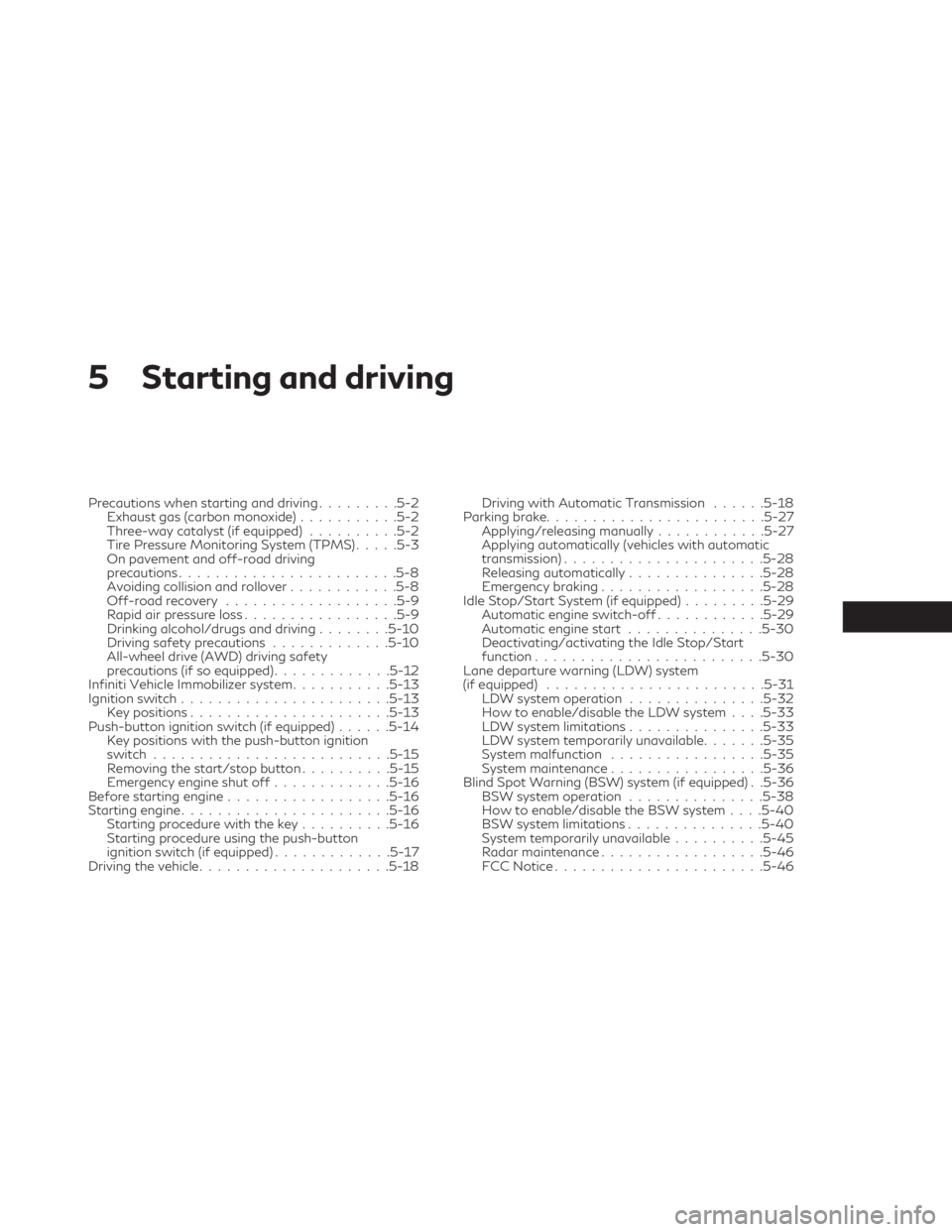
5 Starting and driving
Precautions when starting and driving.........5-2
Exhaust gas (carbon monoxide)...........5-2
Three-way catalyst (if equipped)..........5-2
Tire Pressure Monitoring System (TPMS).....5-3
On pavement and off-road driving
precautions........................5-8
Avoiding collision and rollover............5-8
Off-road recovery...................5-9
Rapid air pressure loss.................5-9
Drinking alcohol/drugs and driving........5-10
Driving safety precautions.............5-10
All-wheel drive (AWD) driving safety
precautions (if so equipped).............5-12
Infiniti Vehicle Immobilizer system...........5-13
Ignition switch.......................5-13
Key positions......................5-13
Push-button ignition switch (if equipped)......5-14
Key positions with the push-button ignition
switch..........................5-15
Removing the start/stop button..........5-15
Emergency engine shut off.............5-16
Before starting engine..................5-16
Starting engine.......................5-16
Starting procedure with the key..........5-16
Starting procedure using the push-button
ignition switch (if equipped).............5-17
Driving the vehicle.....................5-18Driving with Automatic Transmission......5-18
Parking brake........................5-27
Applying/releasing manually............5-27
Applying automatically (vehicles with automatic
transmission)......................5-28
Releasing automatically...............5-28
Emergency braking..................5-28
Idle Stop/Start System (if equipped).........5-29
Automatic engine switch-off............5-29
Automatic engine start...............5-30
Deactivating/activating the Idle Stop/Start
function.........................5-30
Lane departure warning (LDW) system
(if equipped).......................
.5-31
LDW system operation...............5-32
How to enable/disable the LDW system. . . .5-33
LDW system limitations...............5-33
LDW system temporarily unavailable.......5-35
System malfunction.................5-35
System maintenance.................5-36
Blind Spot Warning (BSW) system (if equipped) . .5-36
BSW system operation...............5-38
How to enable/disable the BSW system. . . .5-40
BSW system limitations...............5-40
System temporarily unavailable..........5-45
Radar maintenance..................5-46
FCC Notice.......................5-46
Page 232 of 436
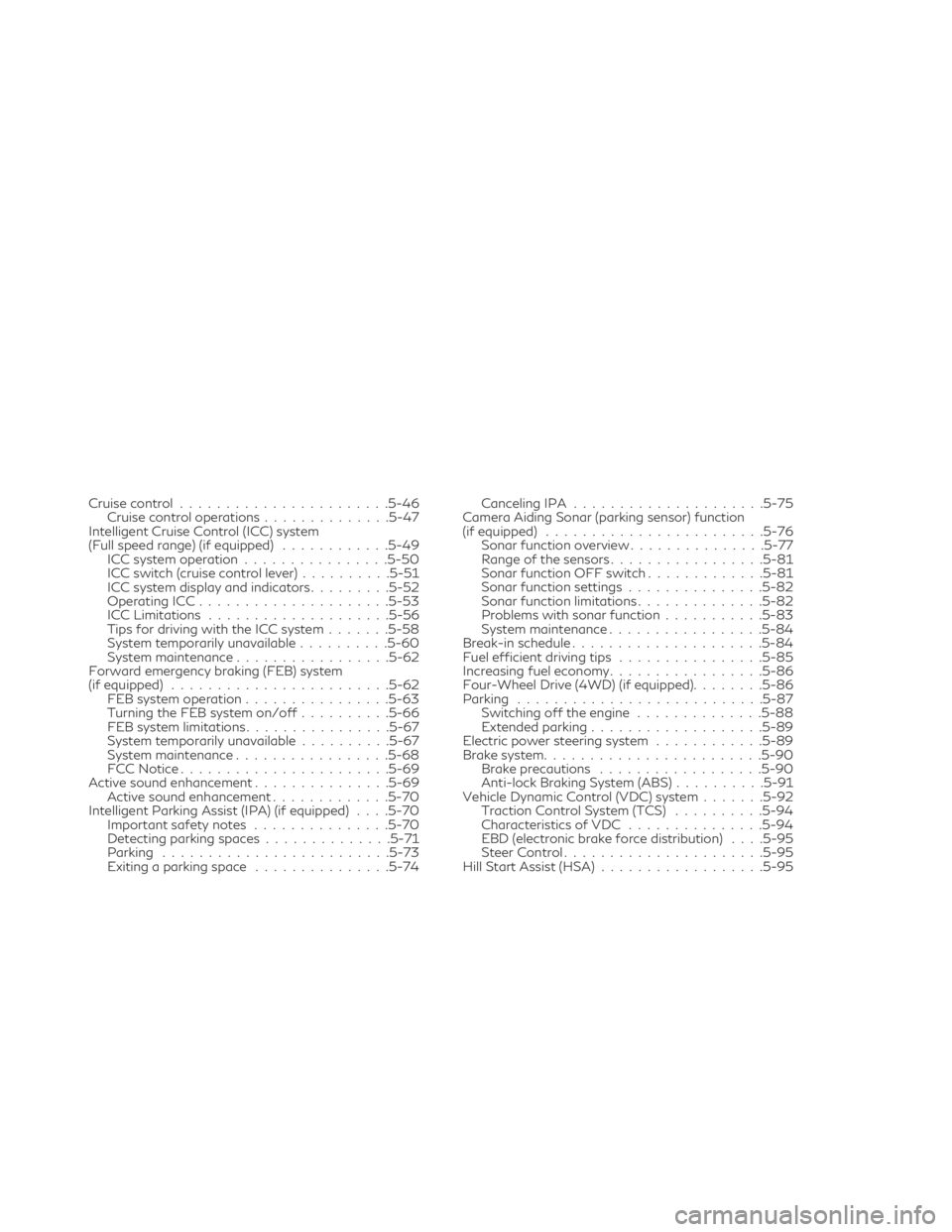
Cruise control.......................5-46
Cruise control operations..............5-47
Intelligent Cruise Control (ICC) system
(Full speed range) (if equipped)............5-49
ICC system operation................5-50
ICC switch (cruise control lever)..........5-51
ICC system display and indicators.........5-52
Operating ICC.....................5-53
ICC Limitations....................5-56
Tips for driving with the ICC system.......5-58
System temporarily unavailable..........5-60
System maintenance.................5-62
Forward emergency braking (FEB) system
(if equipped)........................5-62
FEB system operation................5-63
Turning the FEB system on/off..........5-66
FEB system limitations................5-67
System temporarily unavailable..........5-67
System maintenance.................5-68
FCC Notice.......................5-69
Active sound enhancement...............5-69
Active sound enhancement.............5-70
Intelligent Parking Assist (IPA) (if equipped). . . .5-70
Important safety notes...............5-70
Detecting parking spaces..............5-71
Parking.........................5-73
Exiting a parking space...............5-74Canceling IPA.....................5-75
Camera Aiding Sonar (parking sensor) function
(if equipped)........................5-76
Sonar function overview...............5-77
Range of the sensors.................5-81
Sonar function OFF switch.............5-81
Sonar function settings...............5-82
Sonar function limitations..............5-82
Problems with sonar function...........5-83
System maintenance.................5-84
Break-in schedule.....................5-84
Fuel efficient driving tips................5-85
Increasing fuel economy.................5-86
Four-Wheel Drive (4WD) (if equipped)........5-86
Parking...........................5-87
Switching off the engine..............5-88
Extended parking...................5-89
Electric power steering system............5-89
Brake system........................5-90
Brake precautions..................5-90
Anti-lock Braking System (ABS)..........5-91
Vehicle Dynamic Control (VDC) system.......5-92
Traction Control System (TCS)..........5-94
Characteristics of VDC...............5-94
EBD (electronic brake force distribution). . . .5-95
Steer Control......................5-95
Hill Start Assist (HSA)..................5-95
Page 233 of 436

Cold weather driving...................5-96
Freeing a frozen door lock.............5-96
Antifreeze........................5-96
Battery..........................5-96Draining of engine coolant.............5-96
Tire equipment.....................5-96
Special winter equipment..............5-97
Driving on snow or ice................5-97
Page 234 of 436
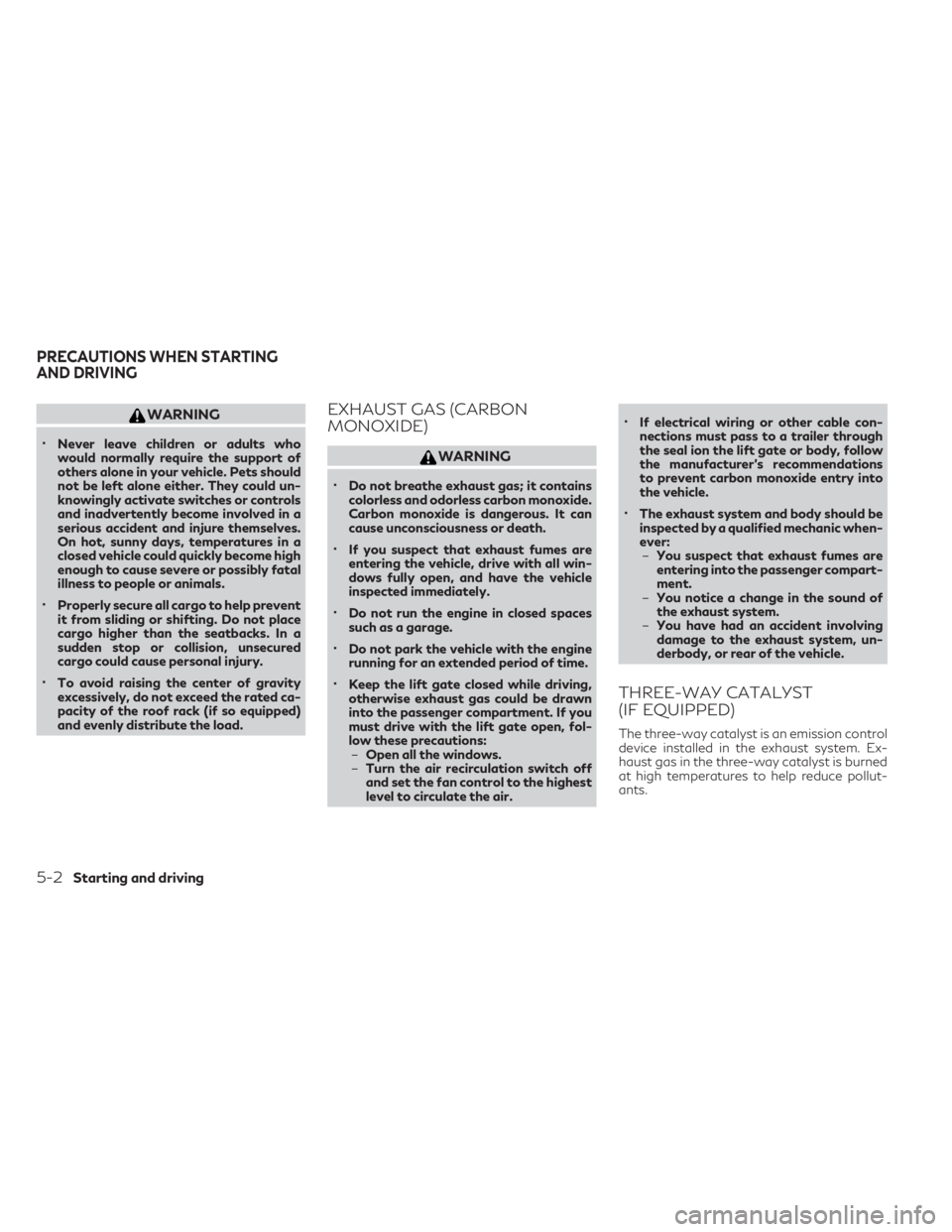
WARNING
•Never leave children or adults who
would normally require the support of
others alone in your vehicle. Pets should
not be left alone either. They could un-
knowingly activate switches or controls
and inadvertently become involved in a
serious accident and injure themselves.
On hot, sunny days, temperatures in a
closed vehicle could quickly become high
enough to cause severe or possibly fatal
illness to people or animals.
•Properly secure all cargo to help prevent
it from sliding or shifting. Do not place
cargo higher than the seatbacks. In a
sudden stop or collision, unsecured
cargo could cause personal injury.
•To avoid raising the center of gravity
excessively, do not exceed the rated ca-
pacity of the roof rack (if so equipped)
and evenly distribute the load.
EXHAUST GAS (CARBON
MONOXIDE)
WARNING
•Do not breathe exhaust gas; it contains
colorless and odorless carbon monoxide.
Carbon monoxide is dangerous. It can
cause unconsciousness or death.
•If you suspect that exhaust fumes are
entering the vehicle, drive with all win-
dows fully open, and have the vehicle
inspected immediately.
•Do not run the engine in closed spaces
such as a garage.
•Do not park the vehicle with the engine
running for an extended period of time.
•Keep the lift gate closed while driving,
otherwise exhaust gas could be drawn
into the passenger compartment. If you
must drive with the lift gate open, fol-
low these precautions:
–Open all the windows.
–Turn the air recirculation switch off
and set the fan control to the highest
level to circulate the air.
•If electrical wiring or other cable con-
nections must pass to a trailer through
the seal ion the lift gate or body, follow
the manufacturer's recommendations
to prevent carbon monoxide entry into
the vehicle.
•The exhaust system and body should be
inspected by a qualified mechanic when-
ever:
–You suspect that exhaust fumes are
entering into the passenger compart-
ment.
–You notice a change in the sound of
the exhaust system.
–You have had an accident involving
damage to the exhaust system, un-
derbody, or rear of the vehicle.
THREE-WAY CATALYST
(IF EQUIPPED)
The three-way catalyst is an emission control
device installed in the exhaust system. Ex-
haust gas in the three-way catalyst is burned
at high temperatures to help reduce pollut-
ants.
PRECAUTIONS WHEN STARTING
AND DRIVING
5-2Starting and driving
Page 235 of 436
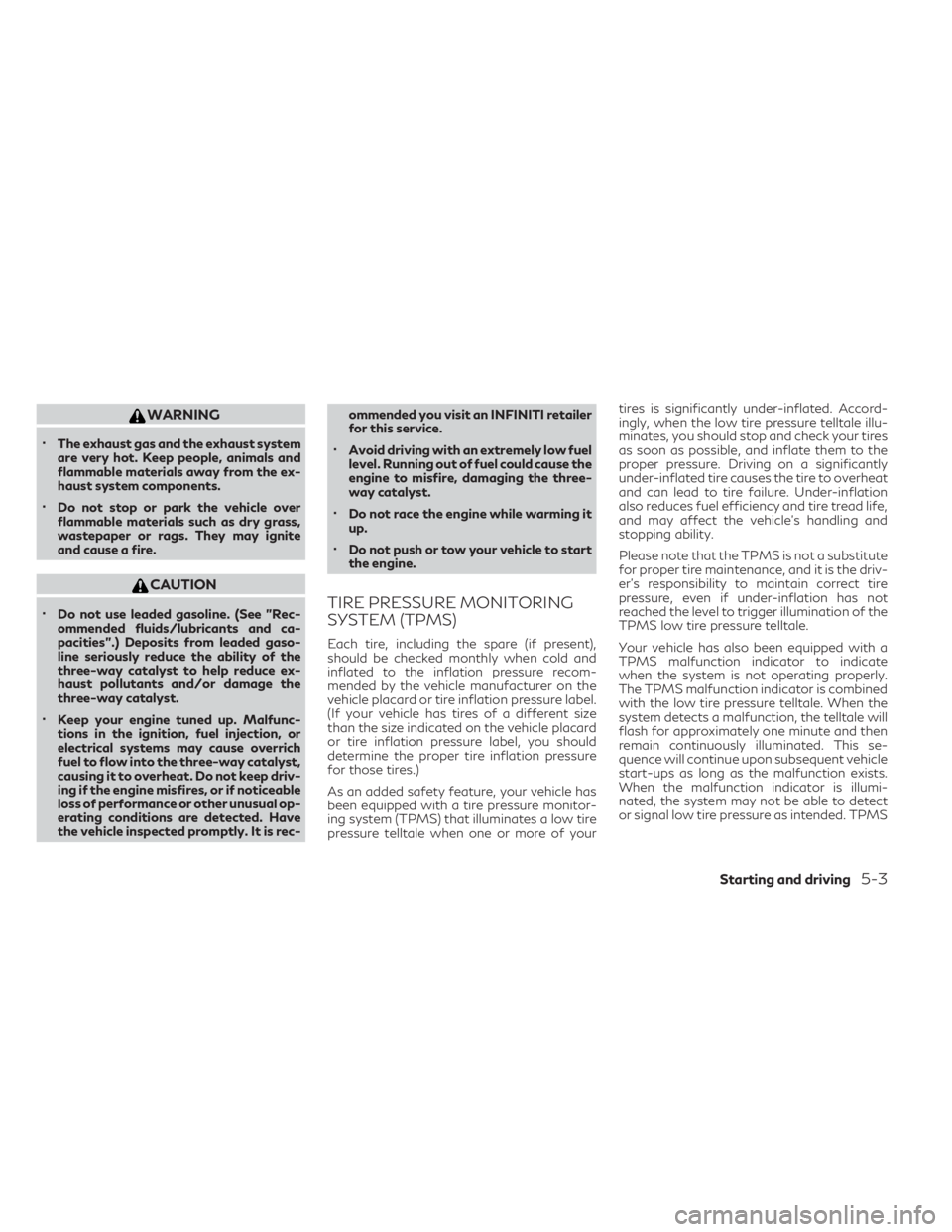
WARNING
•The exhaust gas and the exhaust system
are very hot. Keep people, animals and
flammable materials away from the ex-
haust system components.
•Do not stop or park the vehicle over
flammable materials such as dry grass,
wastepaper or rags. They may ignite
and cause a fire.
CAUTION
•Do not use leaded gasoline. (See "Rec-
ommended fluids/lubricants and ca-
pacities".) Deposits from leaded gaso-
line seriously reduce the ability of the
three-way catalyst to help reduce ex-
haust pollutants and/or damage the
three-way catalyst.
•Keep your engine tuned up. Malfunc-
tions in the ignition, fuel injection, or
electrical systems may cause overrich
fuel to flow into the three-way catalyst,
causing it to overheat. Do not keep driv-
ing if the engine misfires, or if noticeable
loss of performance or other unusual op-
erating conditions are detected. Have
the vehicle inspected promptly. It is rec-ommended you visit an INFINITI retailer
for this service.
•Avoid driving with an extremely low fuel
level. Running out of fuel could cause the
engine to misfire, damaging the three-
way catalyst.
•Do not race the engine while warming it
up.
•Do not push or tow your vehicle to start
the engine.
TIRE PRESSURE MONITORING
SYSTEM (TPMS)
Each tire, including the spare (if present),
should be checked monthly when cold and
inflated to the inflation pressure recom-
mended by the vehicle manufacturer on the
vehicle placard or tire inflation pressure label.
(If your vehicle has tires of a different size
than the size indicated on the vehicle placard
or tire inflation pressure label, you should
determine the proper tire inflation pressure
for those tires.)
As an added safety feature, your vehicle has
been equipped with a tire pressure monitor-
ing system (TPMS) that illuminates a low tire
pressure telltale when one or more of yourtires is significantly under-inflated. Accord-
ingly, when the low tire pressure telltale illu-
minates, you should stop and check your tires
as soon as possible, and inflate them to the
proper pressure. Driving on a significantly
under-inflated tire causes the tire to overheat
and can lead to tire failure. Under-inflation
also reduces fuel efficiency and tire tread life,
and may affect the vehicle’s handling and
stopping ability.
Please note that the TPMS is not a substitute
for proper tire maintenance, and it is the driv-
er’s responsibility to maintain correct tire
pressure, even if under-inflation has not
reached the level to trigger illumination of the
TPMS low tire pressure telltale.
Your vehicle has also been equipped with a
TPMS malfunction indicator to indicate
when the system is not operating properly.
The TPMS malfunction indicator is combined
with the low tire pressure telltale. When the
system detects a malfunction, the telltale will
flash for approximately one minute and then
remain continuously illuminated. This se-
quence will continue upon subsequent vehicle
start-ups as long as the malfunction exists.
When the malfunction indicator is illumi-
nated, the system may not be able to detect
or signal low tire pressure as intended. TPMS
Starting and driving5-3
Page 236 of 436
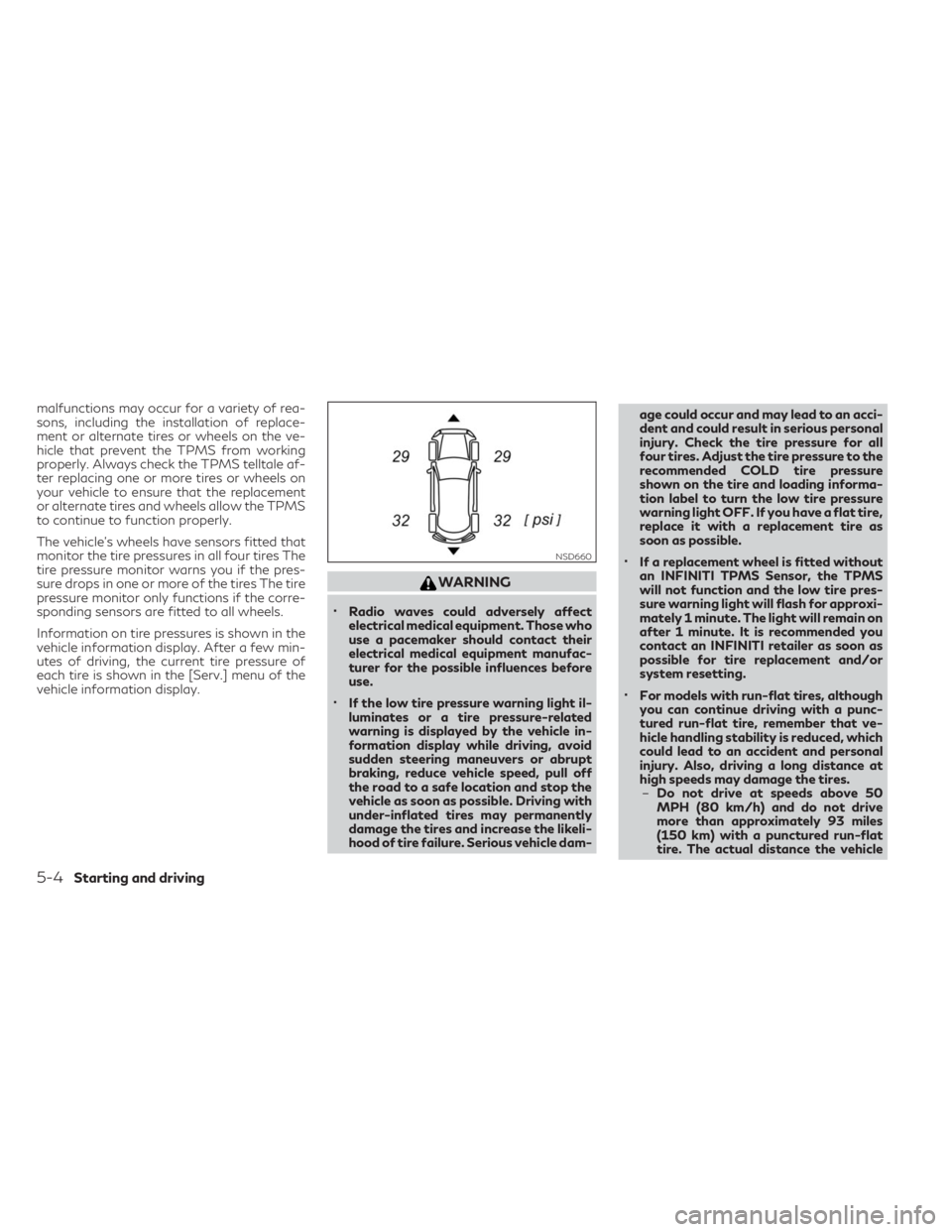
malfunctions may occur for a variety of rea-
sons, including the installation of replace-
ment or alternate tires or wheels on the ve-
hicle that prevent the TPMS from working
properly. Always check the TPMS telltale af-
ter replacing one or more tires or wheels on
your vehicle to ensure that the replacement
or alternate tires and wheels allow the TPMS
to continue to function properly.
The vehicle's wheels have sensors fitted that
monitor the tire pressures in all four tires The
tire pressure monitor warns you if the pres-
sure drops in one or more of the tires The tire
pressure monitor only functions if the corre-
sponding sensors are fitted to all wheels.
Information on tire pressures is shown in the
vehicle information display. After a few min-
utes of driving, the current tire pressure of
each tire is shown in the [Serv.] menu of the
vehicle information display.
WARNING
•Radio waves could adversely affect
electrical medical equipment. Those who
use a pacemaker should contact their
electrical medical equipment manufac-
turer for the possible influences before
use.
•If the low tire pressure warning light il-
luminates or a tire pressure-related
warning is displayed by the vehicle in-
formation display while driving, avoid
sudden steering maneuvers or abrupt
braking, reduce vehicle speed, pull off
the road to a safe location and stop the
vehicle as soon as possible. Driving with
under-inflated tires may permanently
damage the tires and increase the likeli-
hood of tire failure. Serious vehicle dam-age could occur and may lead to an acci-
dent and could result in serious personal
injury. Check the tire pressure for all
four tires. Adjust the tire pressure to the
recommended COLD tire pressure
shown on the tire and loading informa-
tion label to turn the low tire pressure
warning light OFF. If you have a flat tire,
replace it with a replacement tire as
soon as possible.
•If a replacement wheel is fitted without
an INFINITI TPMS Sensor, the TPMS
will not function and the low tire pres-
sure warning light will flash for approxi-
mately 1 minute. The light will remain on
after 1 minute. It is recommended you
contact an INFINITI retailer as soon as
possible for tire replacement and/or
system resetting.
•For models with run-flat tires, although
you can continue driving with a punc-
tured run-flat tire, remember that ve-
hicle handling stability is reduced, which
could lead to an accident and personal
injury. Also, driving a long distance at
high speeds may damage the tires.
–Do not drive at speeds above 50
MPH (80 km/h) and do not drive
more than approximately 93 miles
(150 km) with a punctured run-flat
tire. The actual distance the vehicle
NSD660
5-4Starting and driving
Page 237 of 436
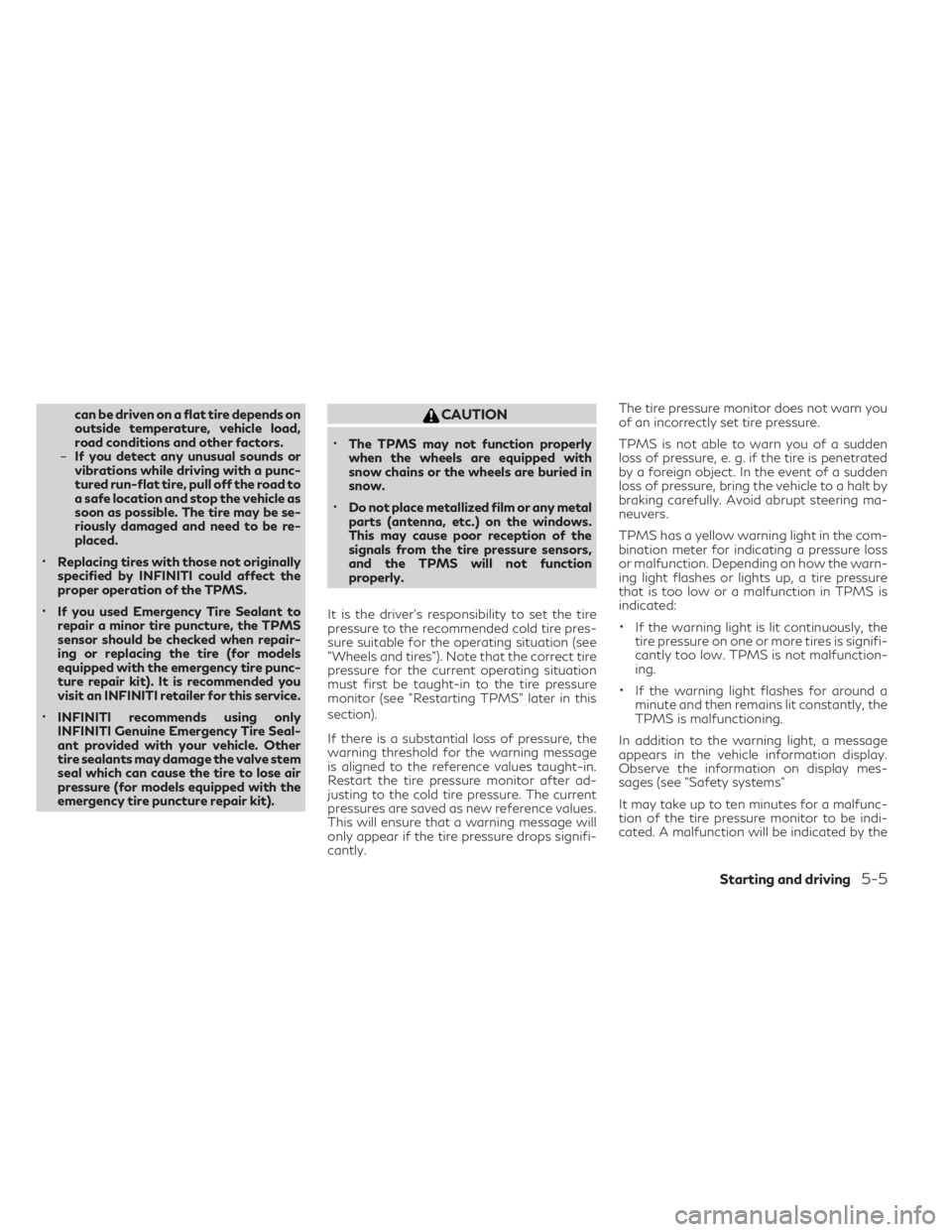
can be driven on a flat tire depends on
outside temperature, vehicle load,
road conditions and other factors.
–If you detect any unusual sounds or
vibrations while driving with a punc-
tured run-flat tire, pull off the road to
a safe location and stop the vehicle as
soon as possible. The tire may be se-
riously damaged and need to be re-
placed.
•Replacing tires with those not originally
specified by INFINITI could affect the
proper operation of the TPMS.
•If you used Emergency Tire Sealant to
repair a minor tire puncture, the TPMS
sensor should be checked when repair-
ing or replacing the tire (for models
equipped with the emergency tire punc-
ture repair kit). It is recommended you
visit an INFINITI retailer for this service.
•INFINITI recommends using only
INFINITI Genuine Emergency Tire Seal-
ant provided with your vehicle. Other
tire sealants may damage the valve stem
seal which can cause the tire to lose air
pressure (for models equipped with the
emergency tire puncture repair kit).
CAUTION
•The TPMS may not function properly
when the wheels are equipped with
snow chains or the wheels are buried in
snow.
•Do not place metallized film or any metal
parts (antenna, etc.) on the windows.
This may cause poor reception of the
signals from the tire pressure sensors,
and the TPMS will not function
properly.
It is the driver's responsibility to set the tire
pressure to the recommended cold tire pres-
sure suitable for the operating situation (see
"Wheels and tires"). Note that the correct tire
pressure for the current operating situation
must first be taught-in to the tire pressure
monitor (see "Restarting TPMS" later in this
section).
If there is a substantial loss of pressure, the
warning threshold for the warning message
is aligned to the reference values taught-in.
Restart the tire pressure monitor after ad-
justing to the cold tire pressure. The current
pressures are saved as new reference values.
This will ensure that a warning message will
only appear if the tire pressure drops signifi-
cantly.The tire pressure monitor does not warn you
of an incorrectly set tire pressure.
TPMS is not able to warn you of a sudden
loss of pressure, e. g. if the tire is penetrated
by a foreign object. In the event of a sudden
loss of pressure, bring the vehicle to a halt by
braking carefully. Avoid abrupt steering ma-
neuvers.
TPMS has a yellow warning light in the com-
bination meter for indicating a pressure loss
or malfunction. Depending on how the warn-
ing light flashes or lights up, a tire pressure
that is too low or a malfunction in TPMS is
indicated:
•If the warning light is lit continuously, the
tire pressure on one or more tires is signifi-
cantly too low. TPMS is not malfunction-
ing.
•If the warning light flashes for around a
minute and then remains lit constantly, the
TPMS is malfunctioning.
In addition to the warning light, a message
appears in the vehicle information display.
Observe the information on display mes-
sages (see "Safety systems"
It may take up to ten minutes for a malfunc-
tion of the tire pressure monitor to be indi-
cated. A malfunction will be indicated by the
Starting and driving5-5
Page 238 of 436

tire pressure warning light flashing for ap-
proximately one minute and then remaining
lit. When the fault has been rectified, the tire
pressure warning light goes out after you
have driven for a few minutes.
The tire pressure values indicated by the ve-
hicle information display may differ from
those measured at a filling station using a
pressure gauge. The tire pressures shown by
the vehicle information display are those
measured at sea level. At high altitudes, the
tire pressure values indicated by a pressure
gauge are higher than those shown by the
vehicle information display. In this case, do
not reduce the tire pressures.
The operation of the tire pressure monitor
can be affected by interference from radio
transmitting equipment (e.g. radio head
phones, two-way radios) that may be being
operated in or near the vehicle.Checking the tire pressure
electronically
1. Make sure that the ignition switch is in the
ON position.
2. Press the
orbutton on the
steering wheel to select the [Serv.] menu.
3. Press the
orbutton to select
[Tire Pressure].
4. Press
The current tire pressure for each wheel
will be displayed in the vehicle information
display.If the vehicle was parked for longer than
20 minutes, the [Tire pressures will be dis-
played after driving a few minutes] message
is shown.
After a teach-in period, the tire pressure moni-
tor automatically detects new wheels or new
sensors. If a clear allocation of tire pressure to
individual wheels is not possible, the Tire pres-
sure monitor active message is shown instead
of the tire pressure display. The tire pressures
are already being monitored.
Ifa replacement wheel is fitted, for a few
minutes the system may continue to show the
tire pressure of the wheel that has been re-
moved. If this occurs, note that the value dis-
played for the position where the replacement
wheel is fitted is not the same as the current
tire pressure of the replacement wheel.
NSD660
5-6Starting and driving
Page 239 of 436
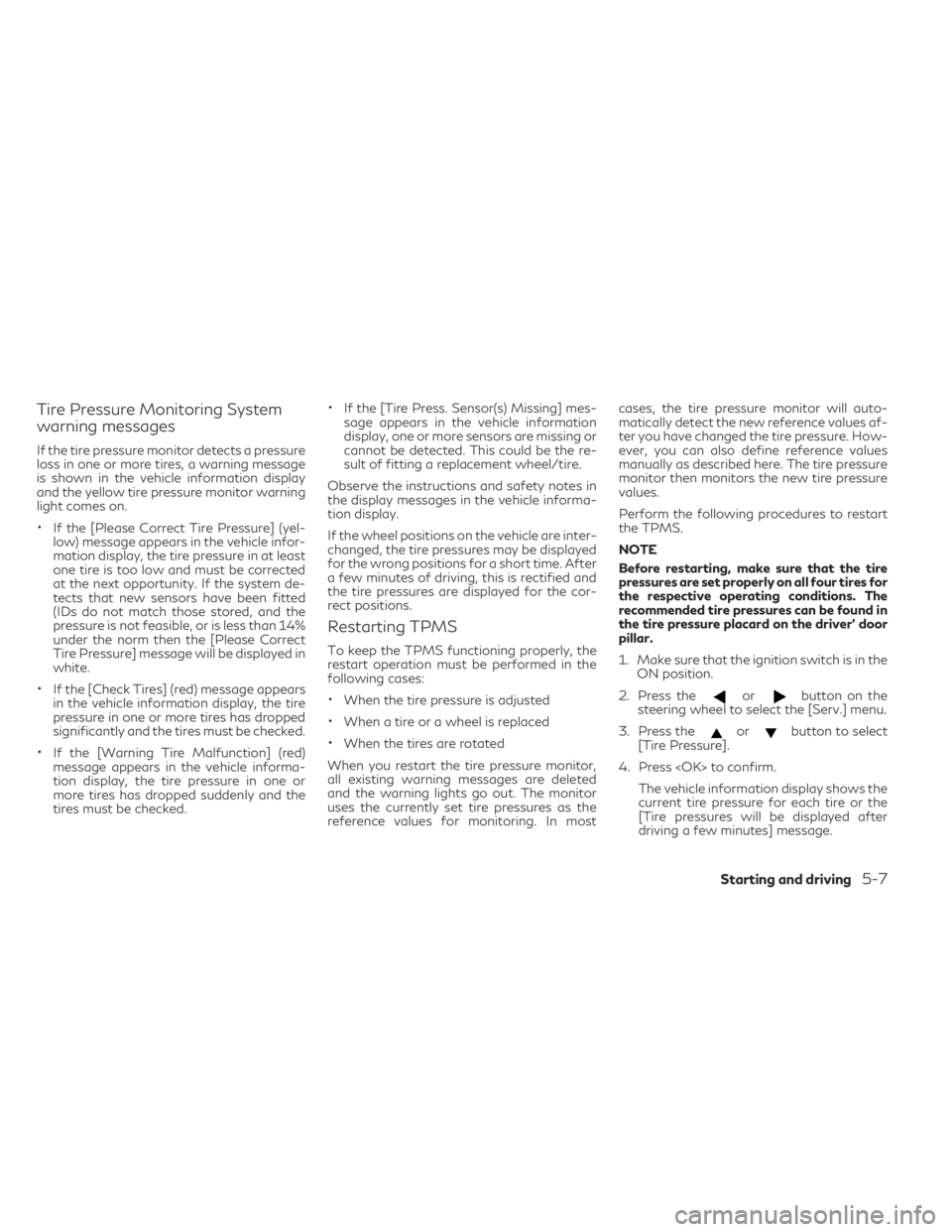
Tire Pressure Monitoring System
warning messages
If the tire pressure monitor detects a pressure
loss in one or more tires, a warning message
is shown in the vehicle information display
and the yellow tire pressure monitor warning
light comes on.
•If the [Please Correct Tire Pressure] (yel-
low) message appears in the vehicle infor-
mation display, the tire pressure in at least
one tire is too low and must be corrected
at the next opportunity. If the system de-
tects that new sensors have been fitted
(IDs do not match those stored, and the
pressure is not feasible, or is less than 14%
under the norm then the [Please Correct
Tire Pressure] message will be displayed in
white.
•If the [Check Tires] (red) message appears
in the vehicle information display, the tire
pressure in one or more tires has dropped
significantly and the tires must be checked.
•If the [Warning Tire Malfunction] (red)
message appears in the vehicle informa-
tion display, the tire pressure in one or
more tires has dropped suddenly and the
tires must be checked.
•If the [Tire Press. Sensor(s) Missing] mes-
sage appears in the vehicle information
display, one or more sensors are missing or
cannot be detected. This could be the re-
sult of fitting a replacement wheel/tire.
Observe the instructions and safety notes in
the display messages in the vehicle informa-
tion display.
If the wheel positions on the vehicle are inter-
changed, the tire pressures may be displayed
for the wrong positions for a short time. After
a few minutes of driving, this is rectified and
the tire pressures are displayed for the cor-
rect positions.
Restarting TPMS
To keep the TPMS functioning properly, the
restart operation must be performed in the
following cases:
•When the tire pressure is adjusted
•When a tire or a wheel is replaced
•When the tires are rotated
When you restart the tire pressure monitor,
all existing warning messages are deleted
and the warning lights go out. The monitor
uses the currently set tire pressures as the
reference values for monitoring. In mostcases, the tire pressure monitor will auto-
matically detect the new reference values af-
ter you have changed the tire pressure. How-
ever, you can also define reference values
manually as described here. The tire pressure
monitor then monitors the new tire pressure
values.
Perform the following procedures to restart
the TPMS.
NOTE
Before restarting, make sure that the tire
pressures are set properly on all four tires for
the respective operating conditions. The
recommended tire pressures can be found in
the tire pressure placard on the driver' door
pillar.
1. Make sure that the ignition switch is in the
ON position.
2. Press the
orbutton on the
steering wheel to select the [Serv.] menu.
3. Press the
orbutton to select
[Tire Pressure].
4. Press
The vehicle information display shows the
current tire pressure for each tire or the
[Tire pressures will be displayed after
driving a few minutes] message.
Starting and driving5-7
Page 240 of 436
![INFINITI QX30 2019 Owners Manual If you wish to confirm the restart:
5. Press <OK> to confirm.
The [Tire Press. Monitor Restarted] mes-
sage appears in the vehicle information
display.
After you have driven for a few minutes,
the sys INFINITI QX30 2019 Owners Manual If you wish to confirm the restart:
5. Press <OK> to confirm.
The [Tire Press. Monitor Restarted] mes-
sage appears in the vehicle information
display.
After you have driven for a few minutes,
the sys](/img/42/35109/w960_35109-239.png)
If you wish to confirm the restart:
5. Press
The [Tire Press. Monitor Restarted] mes-
sage appears in the vehicle information
display.
After you have driven for a few minutes,
the system checks whether the current
tire pressures are within the specified
range The new tire pressures are then
accepted as reference values and moni-
tored
If you wish to cancel the restart:
6. Press the
button.
The tire pressure values stored at the last
restart will continue to be monitored
FCC Notice:
For USA:
This device complies with Part 15 of the FCC
Rules. Operation is subject to the following
two conditions: (1) This device may not
cause harmful interference, and (2) this de-
vice must accept any interference received,
including interference that may cause unde-
sired operation.NOTE
Changes or modifications not expressly ap-
proved by the party responsible for compli-
ance could void the user’s authority to oper-
ate the equipment.
For Canada:
This device complies with Industry Canada
license-exempt RSS standard(s). Operation
is subject to the following two conditions: (1)
this device may not cause interference, and
(2) this device must accept any interference,
including interference that may cause unde-
sired operation of the device.ON PAVEMENT AND OFF-ROAD
DRIVING PRECAUTIONS
Utility vehicles have a significantly higher
rollover rate than other types of vehicles.
They have higher ground clearance than pas-
senger cars to make them capable of per-
forming in a variety of on-pavement and off-
road applications. This gives them a higher
center of gravity than ordinary vehicles. An
advantage of higher ground clearance is a
better view of the road, allowing you to an-
ticipate problems. However, they are not de-
signed for cornering at the same speeds as
conventional 2-wheel drive vehicles any more
than low-slung sports cars are designed to
perform satisfactorily under off-road condi-tions. If at all possible, avoid sharp turns at
high speeds. As with other vehicles of this
type, failure to operate this vehicle correctly
may result in loss of control or vehicle roll-
over. In a rollover crash, an unbelted person is
significantly more likely to die than a person
wearing a seat belt.
For additional information, refer to "Driving
safety precautions" later in this section.
AVOIDING COLLISION AND
ROLLOVER
WARNING
Failure to operate this vehicle in a safe and
prudent manner may result in loss of con-
trol or an accident.
Be alert and drive defensively at all times.
Obey all traffic regulations. Avoid excessive
speed, high speed cornering, or sudden steer-
ing maneuvers, because these driving prac-
tices could cause you to lose control of your
vehicle.
As with any vehicle, loss of control could re-
sult in a collision with other vehicles or ob-
jects or cause the vehicle to roll over, par-
ticularly if the loss of control causes the
vehicle to slide sideways.Be attentive at all
times, and avoid driving when tired. Never
5-8Starting and driving